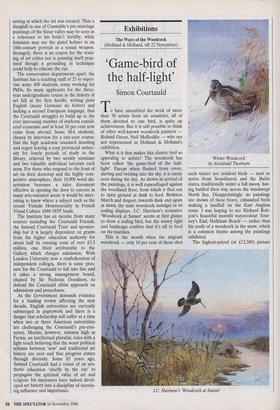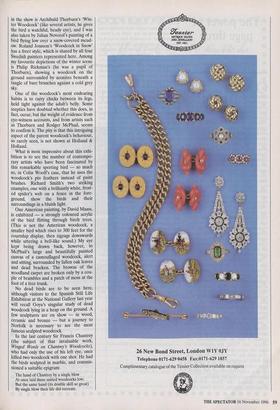Exhibitions
The Ways of the Woodcock (Holland & Holland, till 22 November)
`Game-bird of the half-light'
Simon Courtauld
To have assembled the work of more than 30 artists from six countries, all of them devoted to one bird, is quite an achievement. But it is still possible to think of other well-known woodcock painters Roland Green, Neil McReddie — who are not represented in Holland & Holland's exhibition.
What is it that makes this elusive bird so appealing to artists? The woodcock has been called 'the game-bird of the half- light'. Except when flushed from cover, darting and twisting into the sky, it is rarely seen during the day. As shown in several of the paintings, it is well camouflaged against the woodland floor, from which it flies out to open ground at dusk to feed. Between March and August, towards dusk and again at dawn, the male woodcock indulges in its roding displays. J.C. Harrison's evocative `Woodcock at Sunset' seems at first glance to show a roding bird, but the wintry light and landscape confirm that it's off to feed on the marshes.
This is the month when the migrant woodcock — only 10 per cent of those shot `Winter Woodcock' by Archibald Thorbum each winter are resident birds — start to arrive from Scandinavia and the Baltic states, traditionally under a full moon, hav- ing battled their way across the windswept North Sea. Disappointingly, no paintings are shown of these brave, exhausted birds making a landfall on the East Anglian coast. I was hoping to see Richard Rob- jent's beautiful moonlit watercolour 'Jour- ney's End, Holkham Beach' — rather than his study of a woodcock in the snow, which is a common theme among the paintings exhibited.
The highest-priced (at £12,500) picture .1.C. Harrison's 'Woodcock at Sunset' in the show is Archibald Thorburn's 'Win- ter Woodcock' (like several artists, he gives the bird a watchful, beady eye), and I was also taken by Julian Novorol's painting of a bird flying low over a snow-covered mead- ow. Roland Jonsson's 'Woodcock in Snow' has a freer style, which is shared by all four Swedish painters represented here. Among my favourite depictions of the winter scene is Philip Rickman's (he was a pupil of Thorburn), showing a woodcock on the ground surrounded by aconites beneath a tangle of bare branches against a cold grey sky.
One of the woodcock's most endearing habits is to carry chicks between its legs, held tight against the adult's belly. Some sceptics have doubted whether this does, in fact, occur, but the weight of evidence from eye-witness accounts, and from artists such as Thorburn and Rodger McPhail, seems to confirm it. The pity is that this intriguing aspect of the parent woodcock's behaviour, so rarely seen, is not shown at Holland & Holland.
What is most impressive about this exhi- bition is to see the number of contempo- rary artists who have been fascinated by this remarkable sporting bird — so much so, in Colin Woolf's case, that he uses the woodcock's pin feathers instead of paint brushes. Richard Smith's two striking examples, one with a brilliantly white, frost- ed spider's web on a fence in the fore- ground, show the birds and their surroundings in a bluish light.
One American painting, by David Maass, is exhibited — a strongly coloured acrylic of the bird flitting through birch trees. (This is not the American woodcock, a smaller bird which rises to 300 feet for the courtship display, then zigzags downwards while uttering a bell-like sound.) My eye kept being drawn back, however, to McPhail's large and beautifully painted canvas of a camouflaged woodcock, alert and sitting, surrounded by fallen oak leaves and dead bracken. The browns of the woodland carpet are broken only by a cou- ple of brambles and a patch of moss at the foot of a tree trunk.
No dead birds are to be seen here, although visitors to the Spanish Still Life Exhibition at the National Gallery last year will recall Goya's singular study of dead woodcock lying in a heap on the ground. A few sculptures are on show — in wood, ceramic and bronze — but a journey to Norfolk is necessary to see the most famous sculpted woodcock.
In the last century Sir Francis Chantrey (the subject of that invaluable work, Winged Words on Chantrey's Woodcocks), who had only the use of his left eye, once killed two woodcock with one shot. He had the birds sculpted in marble, and commis- sioned a suitable epigram:
The hand of Chantrey by a single blow At once laid these united woodcocks low; But the same hand (its double skill so great) By single blow their life did recreate.



















































































 Previous page
Previous page